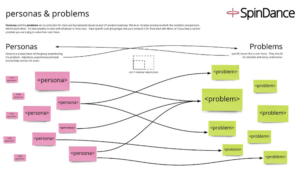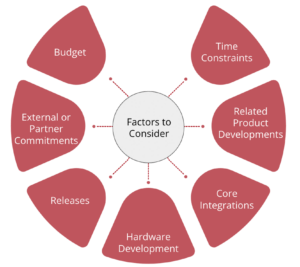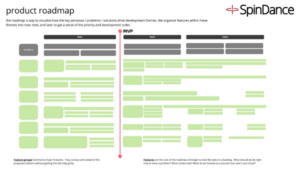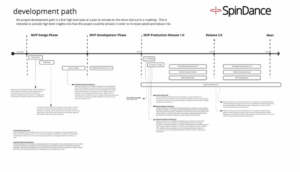Want a Successful IoT Project? Build an IoT Product Roadmap.
Knowing where you are going is important to achieve your business goals. Think of how GPS technology has transformed the way we navigate through our daily lives. We can get from point A to point B in the most efficient way possible, and we almost never get lost. In product development it is equally important to have tools that will guide you through the process. Unfortunately, unlike GPS, there is no service that can automatically map out a successful path for you.
At SpinDance, we work with a variety of clients that are at different stages in their product development journey. In addition to our software engineering service, we also offer consulting services to help establish product plans that our clients can use during development and beyond. One of our primary tools in this effort is an IoT Product Roadmap.
An IoT Product Roadmap allows stakeholders and contributors to align expectations and provide a solid understanding of the product development process. Our carefully crafted IoT Product Roadmap will facilitate these expectations and better communicate timing, budget, and resourcing across the organization. This gets everyone on the same page and helps accelerate the timeline.
To be most effective, Roadmaps must be:
- User Centric instead of detailed requirements documentation
- Context-aware instead of isolated
- Strategic instead of reactionary
Let’s look at those three attributes in more detail.
Roadmaps are User Centric
Often when a team starts planning a new product the focus turns too quickly to how it is going to happen, when it will be done, and how much it will cost. These are all very important questions, but at the beginning of product development the more important questions are for whom are we building and what do they (users) need and want. If you don’t get the who and what answers right, then the how, when, and how much questions are irrelevant.
Typically one of the first workshop exercises we do as part of an IoT Product Roadmap engagement is to map out User Personas and Target Problems.
The Who: User Personas
User Personas are a way of organizing and documenting the different types of users for whom you are building. Many IoT platforms and products have multiple user personas and each of these have their own set of use cases, expectations, etc. Identifying the nuances in the personas helps determine system requirements and prioritize the competing or divergent needs between different types of users.
The What: Target Problems
Target Problems are just that… the problems your platform/product is trying to solve for the core user personas. Identifying these specific problems up front makes it much more likely that you will be able to solve them before you even start the project.
Personas and Problems are closely related, and we work through mapping those relationships.
Knowing who you are building for and what problems you are trying to solve is the most critical component of the project. The information gained from these exercises will guide the team throughout the entire product development process.

Roadmaps are Context Aware
Product development rarely happens in isolation; every project has external factors. These vary depending on the context but can include:

With a Roadmap you can keep the product vision central but also start to plan for and manage the critical externalities. By identifying the outside factors that can affect the project early, you can start to make strategic decisions and hopefully avoid reactionary decisions later.
For example, let’s say that you are developing a new connected platform with a suite of connected products. If a different division at your organization has a connected product that they plan to migrate to your new platform, you will want to take that into account and plan for it before development begins. If this is identified on a Roadmap the design team will communicate it to the development team through a prioritized backlog of work. This means the right work items will get prioritized to make that integration possible.
On the other hand, if that integration requirement isn’t identified until after development has started there may be a lot more cost and re-work to make it possible.
This kind of active management is even more critical when there is more than one externality. In complicated IoT projects, there are generally multiple external factors that will affect the process and outcome.
An Inexpensive “No”
Another outcome of the IoT Product Roadmap is a very inexpensive “No”. This means learning early on that an aspect of the project (i.e. a feature) is not viable within your context or constraints. Identifying this misalignment before starting the actual development will likely save significant time and money. It’s much better to identify misalignments early.
As an example, if you hire an architect to design a luxury home with a budget of $250 per square foot they are going to tell you, “No, luxury homes cost $500 per square foot.” This may not seem like good news, but it’s much better news then if you find out after you pour the luxury foundation and can’t afford the rest of the house.
A good designer/architect won’t tell you to get lost, they will work with you to refine the vision for what you want to build and take into consideration your specific constraints. Maybe you can live in a house half the size you initially planned on, or maybe there are a few “luxuries” that you really want and can make some simplifications to make the math work. Or maybe you can prioritize your other financial constraints and increase your budget. In any case this early “no” helps to clarify priorities and define expectations.
Constraints, if identified early, are really just opportunities for creative solutions that can create significant competitive advantages.
Roadmaps are Strategic
Navigating a product’s development without a Roadmap is like deciding at every corner which way to turn. You may eventually get where you want to go, but it will be inefficient and the likelihood of getting lost is much higher. Providing long-term context for a product’s development provides a framework for making the best short- and medium-term decisions needed to move towards the long-term vision.
Communication
Crafting a new product is hard. Explaining a new product in detail that doesn’t exist yet is even harder. Even if the underlying concept is solid, distilling the core ideas into a message that everyone on the team can understand can be nearly impossible. Most of us have seen a situation where coworkers are on the same project and share the same end goal, yet spend weeks or more talking around each other about how to move forward.
A Roadmap can be a valuable tool for communicating internally within an organization, especially during the early stages of product development. The team will be able to work constructively towards alignment if the Roadmap can serve as a tool for common understanding. This allows your team to focus more on strategy and moving forward and less on trying to communicate and/or interpret how the project should proceed.
Timing
A Roadmap also provides guidance on timing without actually being a timeline. Any timeline created at this early stage will be inaccurate and misleading as there are simply too many unknowns. That being said, product development doesn’t happen in isolation and it will have timing-related constraints and goals. A high-level view of how the project will progress through time, and the order in which major developments need to happen can be helpful. This high-level view will enable your team to proactively plan for future needs of the project; team resourcing, partners, funding/budgeting, test planning, etc. The ability to plan for the future without being locked into a timeline is a big strategic advantage, allowing you to plan and stay agile simultaneously.
Roadmap Deliverables
At the conclusion of an IoT Product Roadmap engagement we provide a set of deliverables that document the roadmapping process and outcomes. These can be used as communication tools, reference documents, and inputs into a design phase. These documents extend the value of a roadmapping initiative beyond the workshops and discussions that take place during the engagement.
Report
The written report provides a high-level overview of the roadmapping process and the products in question. This report will document the context of the product development and may cover critical components in more detail depending on the product. We also document key recommendations in the report as a reference for next steps.
Product Roadmap
An IoT Product Roadmap is focused on showing how product themes develop over time and incorporates key features.
Along the vertical axis we break the product into themes; often major features (or feature groups). They could also be integrations, different hardware revisions, or other components in the product ecosystem that will develop over time.
Along the horizontal axis we break the project down in temporal divisions; generally we use Now, Next, and Later. This is typically advantageous when the product development timing is not well understood, like in the case of a brand new product.
At other times we may choose to break it down by releases (MVP, 1.0, 2.0) or by quarter (Q1, Q2, etc.). This approach is often used on products in which the timing is either well understood and/or very critical. In these cases it’s important to break down the timeline in more detail.

Development Path
The development path is a bridge between the IoT Product Roadmap and an execution plan; it is NOT an actual execution plan or timeline. It helps lay out the major phases and what development services will be needed within each phase. This is a tool that can aid in strategic decision making about how the product development will progress over time and can be a valuable communication tool.

Conclusion
IoT product development is a huge undertaking involving a lot of investment in terms of people, cost, risk, and creative energy. An IoT Product Roadmap is a low-investment first step to help frame up what you envision developing and how that integrates into your organization’s strategic plan. An overall integrated view highlights major misalignments and/or opportunities that may not have been obvious at the onset. Identifying these risks and opportunities early in the product development can be incredibly valuable, allowing your team to leverage your unique advantages and avoid critical risks.
A well-executed IoT Product Roadmap will provide a huge kickstart to the next step in your product strategy. It gives the design team a synthesized and clarified view of your product that can be a basis for the initial system design.
No matter at what stage your team’s product development is, we’d love an opportunity to work with your organization to map out a successful future for your connected product.
Written by Daniel Luyk, Product Owner at SpinDance. You can contact him at daniel.luyk@spindance.com.
Learn more about our IoT Product Roadmaps here.